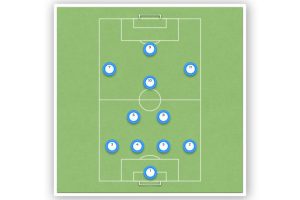How To Improve Your Crossing As A Wide Midfielder
You’ve come to the right place if you’re a wide midfielder looking to improve your crossing! The key is practice and repetition.
In this article, we’ll look at some tips and techniques that will help you become more accurate with your crosses in no time. With enough dedication, anyone can learn how to deliver pinpoint-accurate crosses into the box for their teammates.
Let’s get started!
Developing Good Habits
As a wide midfielder, improving your crossing is an important skill to focus on. Exploring angles and analyzing options when you’re attacking are key for successful crosses.
Look for open channels of space in the defense, and make sure your timing lines up with your teammates’ runs. When passing across the pitch, consider how much weight to put on each pass—too little or too much can ruin the play.
Aiming low passes allows them to travel further while avoiding defenders’ heads. As well as finding ways to break through defensive lines by using long balls over the top, it’s essential to be able to read plays quickly and know when a cross might work best.
Knowing which type of delivery is necessary in any given situation will help you deliver effective crosses more often than not. Developing good habits around decision-making and making use of available resources will go a long way towards improvement in this area.
With sound technique and practice, you’ll be ready to take your game to the next level.
Improving Your Technique
Crossing as a wide midfielder is an art. You need to analyze the angles, adapt your speed and timing to create space for yourself and others on the pitch during a game or training session. With practice comes perfection – if you can perfect your technique of crossing, it can give you tremendous success in attacking play.
Here are some key tips to help improve your crossing:
- Analyze angles: Take a few moments before making a cross to survey the area around you, look at where defenders and attackers are positioned so that you can accurately decide which angle would be best suited for the incoming pass.
- Adapt speed: It’s important to adjust both how hard and fast you make the pass based on who will receive it; depending on their positioning, they may not have enough time or ability to control the ball with a harder pass while too soft of one could leave them off balance without having full control over the ball either.
- Positioning: Make sure when receiving the ball from other teammates that your body is facing towards goal so that it puts less pressure on your legs when attempting crosses. This way, more power and accuracy can be generated when attempting passes across field.
- Timing: When making crosses into dangerous areas, proper timing must be taken into account – know exactly when to take risks by sending in balls early versus late, taking into account further variables such as defender vs attacker count & positioning near target area etc., as well as any potential changes in wind direction/speed throughout match day itself.
- Control: Crosses require good first touch control – practice controlling different types of passes coming from various heights and speeds in order to maximize efficiency when performing crosses out onto field.
By keeping these details in mind and practicing regularly, you’ll find yourself becoming increasingly comfortable with crossing techniques – thus allowing for higher levels of performance within matches themselves!
To continue improving upon this skill set even further, turning attention towards practicing crosses specifically within training sessions should become next priority.
Practicing Crosses In Training
Continuing on from the previous section about improving one’s technique, it is essential to practice crosses in order for a wide midfielder to successfully improve their crossing capabilities. Practicing crosses can be done both alone and with teammates, each having its own unique benefits.
| Benefits | Solo Training | Teamwork |
|---|---|---|
| Finding Space | Yes | No |
| Timing Accuracy | Yes | Yes |
| Utilizing Visualization Techniques | Yes | No |
Practicing solo allows you to perfect your control over the ball and find space without pressure from other players or an opposing team.
The ability to identify open spaces when receiving passes and making runs off the ball are vital when playing as a wide midfielder. On the other hand, teamwork offers an opportunity to work on accuracy of timing during crosses while being put under more realistic conditions than if they were training alone.
Working together also creates better understanding between team members, leading to fluidity within match play. As such, incorporating both solo and team-based drills into your routine will maximize results in terms of improved crossing ability.
Visualization techniques should also be utilized regularly by all soccer players when honing their skills; this includes visualizing what kind of pass or cross you will make before receiving the ball, deciding where you want to place a shot before taking it etc.
This helps build muscle memory so that executing these moves becomes second nature – something every player must strive for! With enough dedication, any individual has the potential to become an elite wide midfielder capable of delivering accurate, powerful crosses at just the right moment.
Utilizing Visualization Techniques
Crossing is an integral part of a wide midfielder’s game, and improving it can take your play to the next level.
To do this effectively, you must use visualization techniques to see the angles clearly in your mind before attempting them on the pitch. Visualization requires intense mental preparation as you imagine yourself executing each move perfectly so that when you actually attempt it out on the field, everything feels natural and effortless.
You will be able to judge distances between players more accurately and make decisions faster due to how much time you spend preparing mentally for the match. With proper visualizing skills, even complex movements like crossing become second nature.
Transitioning smoothly into the next step, learning from professional players’ examples can help further hone these crossed ball abilities until they are perfected.
Learning From Professional Players
One of the best ways to improve your crossing as a wide midfielder is to learn from professional players. Watching professionals execute runs, track back and defend, control their body positioning, and deliver crosses accurately can help you develop your own skills.
It’s important to watch how they make decisions on when to cross or pass in different situations, so that you can develop your decision-making muscle memory too. Understanding how they use body positioning and ball placement to create space for themselves will also help you increase accuracy and power in your crosses.
Take note of how they interact with other players during attacks: it is often necessary to coordinate movements with teammates if you are going to provide good service into the box.
Practicing these techniques consistently is the key to mastering each element and putting them together in matches effectively.
With dedication and hard work, you will be able to refine all aspects of your game until you become a top-level wide midfielder!
Frequently Asked Questions
What Specific Drills Can I Use To Practice Crossing?
Are you looking for drills to practice your crossing as a wide midfielder? Look no further!
Timing technique and aerial delivery are key when it comes to mastering the art of crossing. To work on these skills, try practicing from different angles with stationary targets. Place some cones in the ground and mark out specific areas to aim for; this will help hone your accuracy and timing.
You can also use a partner or teammate to simulate an opposing defender, which will help improve your ability to deliver crosses under pressure.
Is There A Certain Body Position I Should Maintain While Crossing?
Maintaining the right body position is essential to successful crossing as a wide midfielder.
When attempting a cross, you should focus on keeping your passing angles open and adjusting your alignment to maximize ball speed.
This will help ensure that you are able to get the most power and accuracy out of each delivery.
Keeping your shoulder in line with where you want the ball to go can also improve your overall success rate when it comes to crossing.
How Can I Increase The Accuracy Of My Crosses?
If you want to hit a bulls-eye with your crosses, then ball placement and timing technique are key.
To increase the accuracy of your crosses, it helps to focus on getting the perfect weight when delivering them; too strong or too weak will result in an unsuccessful cross.
Use your body position as well – positioning yourself correctly before striking can help guarantee that the ball reaches its target.
It’s important to practice often and refine these techniques so they become second nature – only then will you be able to ‘hit the nail on the head’ every time.
How Often Should I Practice Crossing?
Crossing is a key skill for any wide midfielder and it takes practice to improve.
To increase accuracy, timing drills are the way to go – they can help you get used to placing your crosses with precision.
Ball placement is also important when crossing, so it’s essential to practice this often in order to perfect technique.
As a rule of thumb, aim for at least 1-2 sessions per week dedicated solely to practicing crossing and ball placement if you want to see results over time.
What Type Of Ball Should I Use While Practicing Crossing?
When it comes to honing your crossing skills as a wide midfielder, the type of ball you use while practicing is hugely important.
Using one that’s too light won’t give you the same resistance and feedback when performing timing drills or tactical awareness exercises as an authentic soccer ball would.
On the other hand, using a heavy or hard-surfaced ball could cause problems with accuracy in your passing and finishing.
For optimal results, look for a medium weighted size 5 ball that has been designed specifically for training – this will ensure good control and improved technique so you can master those perfect crosses!
Conclusion
Crossing is an important skill for wide midfielders to have in order to be successful. With the right drills and practice, you can improve your crossing quickly and become a stronger player on the field.
I suggest focusing on developing accuracy by using specific body positioning while crossing and practicing with different types of balls frequently. Allusion could include comparing yourself to some of the greats such as Ronaldo or Beckham; if they can do it, so can you!
Before long, you will be whipping crosses into the box like one of the pros – don’t forget the hard work that got you there.






